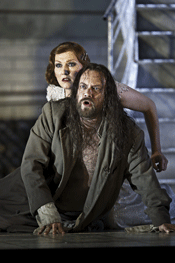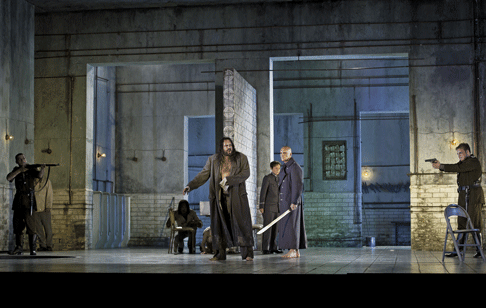The House of Horrors element that irritated considerably last time seemed softened, replaced by a lighter, more humorous form of camp. Perhaps this were so, or maybe it was just a case of knowing what was coming; at any rate, in this of all operas, a somewhat lower level of sensationalism was gratefully received.
 Johan Reuter as Jokanaan and Angela Denoke as Salome
Johan Reuter as Jokanaan and Angela Denoke as Salome
There is something to be said, I suppose, for the transformation of Herod and Herodias into comic characters, though there was perhaps a little too much of the world of the sitcom to their behaviour. More fundamentally, I remain unsure why the work was updated to the inter-war years 1920s: not that I have any specific objection to it, but little was made of it, beyond perhaps the sense of a violent society — but what society is not? — and the still-problematical caricaturing of the Jews. Wilde, Hedwig Lachmann, and Strauss really do not need any help in that regard. McVicar’s Dance of the Seven Veils witnessed second time around was no surprise, but it remains perverse. Salome gains clothes rather than lose them, as she appears to relive her childhood with the suggestion of Herod as her abuser. Es Devlin’s set retains its striking appeal, the split-level ‘upstairs-downstairs’ arrangement providing glimpses of the Tetrarch’s dinner party proceeding above, until the guests repair below — somewhat oddly, given the distinctly unglamorous nature of the basement. The costumes are generally equally striking, not least in the case of the typical McVicar array of extras: the guests and various household functionaries, including an array of pretty waiters in tight uniforms. And then there is Naaman, the executioner, whom McVicar has transformed into a principal — though necessarily dumb — character, played once again by the muscular street entertainer from Covent Garden market, Duncan Meadows. I have yet to be enlightened as to why he would have stripped off whilst down in the cistern, but his bloodstained reappearance doubtless titillated some. There was quite a bit of casual nudity elsewhere but the only truly erotic moment was that of Salome’s fatal kiss, which certainly retained its horror, and rightly so.
Hartmut Haenchen’s account of the score took a while to get going; I seem to recall a similar trajectory when I heard him conduct Salome a few years ago in Paris. However, after the first half an hour or so, he captured a fine balance between demands of the dance and colouristic fantasy. The orchestra was on fine form after a slight initial thinness of tone, strings gleaming as if instantiating the jewels with which the Tetrarch vainly tries to pay off Herodias’s daughter.
Angela Denoke put up a valiant attempt in that role. She paid commendable attention to the words, give or take a few peculiar consonants, but lacked the sheer physicality of Nadja Michael in 2008. Denoke appears a little too much the elegant woman of a certain age. Moreover, the more extreme demands placed upon her by Strauss found this Salome almost as severely parted as her predecessor, albeit closer to the prescribed pitches. McVicar’s conception of Jokanaan — a ‘Beckettian tramp soaked in sewage’ — does not assist a singer’s assumption of the role, but Johan Reuter proved a worthy successor to Michael Volle, providing an aptly lumbering physical presence, expressed through his voice as much as his acts. Gerhard Siegel and Irina Mishura impressed in their way as the Herods, amusing if not necessarily regal. Andrew Staples presented a credibly sympathetic portrayal of Narraboth, who is after all the only sympathetic character in the drama, though memories of Joseph Kaiser last time around were undimmed. Smaller parts were generally well taken, the chattering Jews especially — whatever resultant discomfort one might feel.
 From Left to Right: Nicolas Courjal as First Soldier, Johan Reuter as Jokanaan, Sarah Castle as Page Of Herodias, Duncan Meadows as Naaman and Andrew Staples as Narraboth
From Left to Right: Nicolas Courjal as First Soldier, Johan Reuter as Jokanaan, Sarah Castle as Page Of Herodias, Duncan Meadows as Naaman and Andrew Staples as Narraboth
If there was something of an end-of-term feeling to this revival, which comprises but five performances, everything was commendably professional. Ultimately, however, I do not feel that the production gets to the heart — if heart Salome has — of the work. I remain hopeful that Harry Kupfer’s stunning production for the Staatsoper Unter den Linden will see the light of day on DVD. In the meantime, there is amusement to be had here.
Mark Berry
Click here for video trailer of this production.
image=http://www.operatoday.com/SALOME-100701_0446-DENOKE-A.gif
image_description=Angela Denoke as Salome [Photo by The Royal Opera/ Clive Barda]
product=yes
product_title=Richard Strauss: Salome
product_by=Narraboth: Andrew Staples; Herodias’s Page: Sarah Castle; First Soldier: Nicolas Courjal; Second Soldier: Alan Ewing; Jokanaan: Johan Reuter; A Cappadocian: John Cunningham; Salome: Angela Denoke; A Slave: Andrea Hazell; Herod: Gerhard Siegel; Irina Mishura: Herodias; First Jew: Adrian Thompson; Second Jew: Robert Anthony Gardiner; Third Jew: Hubert Francis; Fourth Jew: Steven Ebel; Fifth Jew: Jeremy White; First Nazarene: Vuyani Mlinde; Second Nazarene: Dawid Kimberg; Naaman: Duncan Meadows; Guests of Herod. Director: David McVicar; Revival Director: Justin Way; Designs: Es Devlin; Lighting: Wolfgang Gˆbbel; Choreography and Movement: Andrew George; Revival Choreography: Emily Piercy; Video Designs: Leo Warner and Mark Grimmer for Fifty-Nine Productions. Orchestra of the Royal Opera House; Hartmut Haenchen (conductor). Royal Opera House, Covent Garden, London, Saturday 3 July 2010.
product_id=Above: Angela Denoke as Salome
All photos by The Royal Opera/ Clive Barda